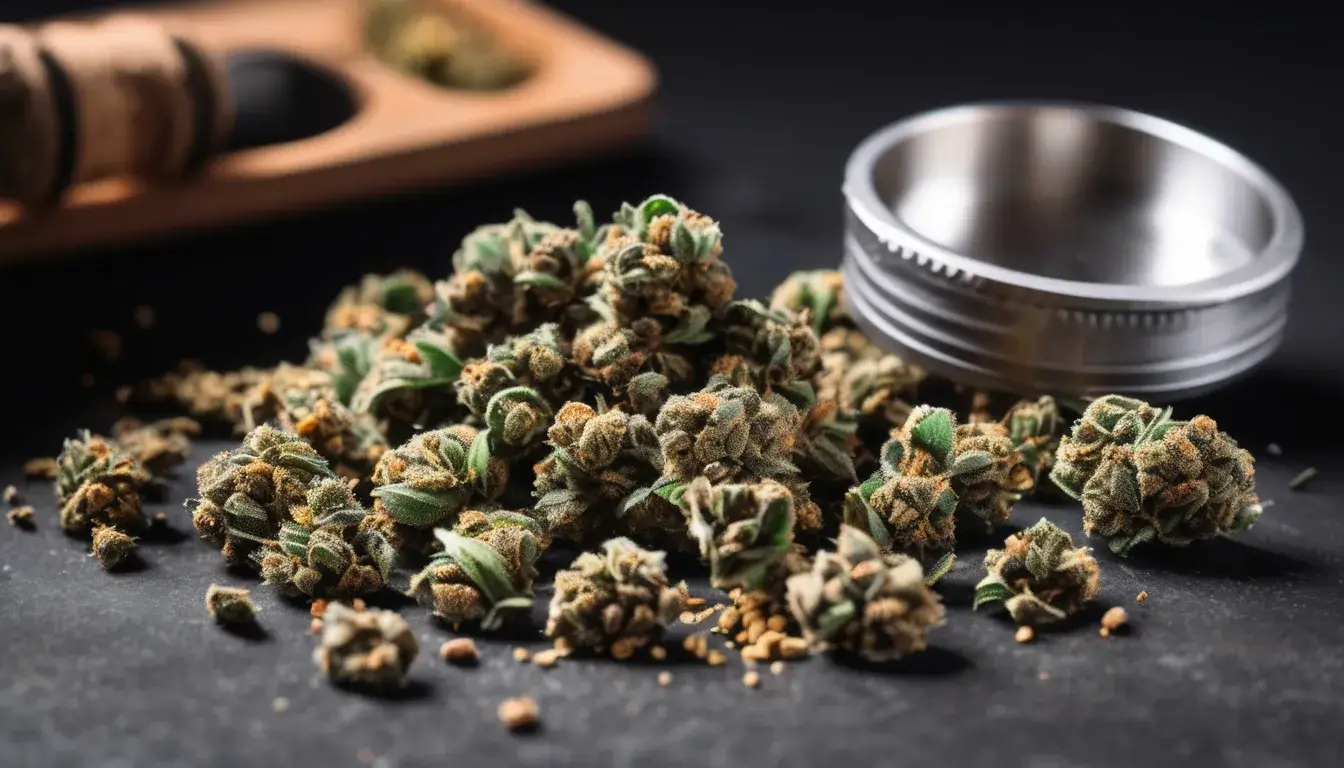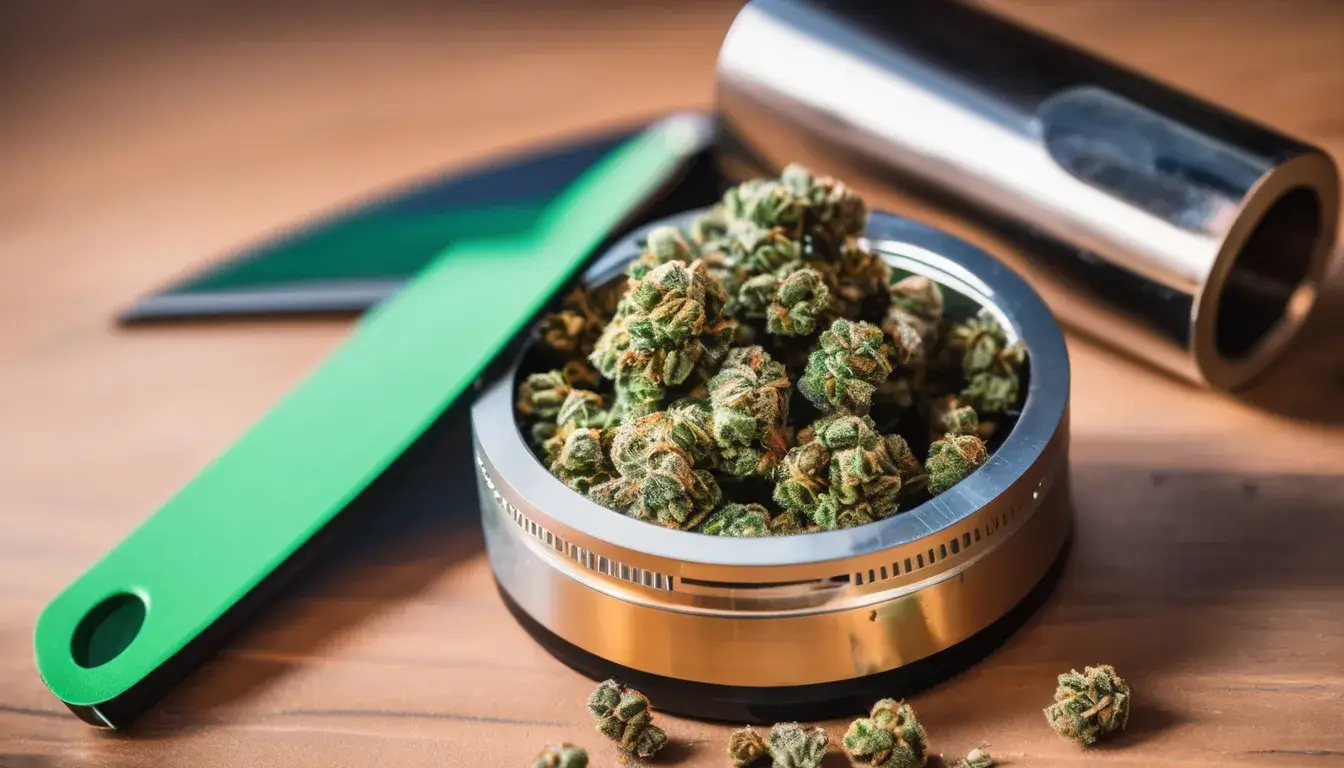Key Takeaways
- Utilize everyday items like scissors, knives, or a coffee grinder to achieve finely ground cannabis when a traditional grinder isn’t available.
- Ensure optimal dryness for effective grinding, preserving the integrity of trichomes for better flavor and potency.
- Regular cleaning of grinding tools prevents residue buildup, ensuring consistent flavor and quality of cannabis.
Grinding weed is a fundamental step for those seeking to maximize its efficacy and enjoyment. Properly ground cannabis ensures an even burn and optimal release of both flavor and active compounds, such as THC and CBD.
However, it’s not uncommon to find oneself ready to prepare cannabis without access to a grinder. This situation prompts the need for creative yet effective alternatives.
This article explores the importance of grinding and discusses various methods to achieve finely ground weed when traditional tools are not available, ensuring that every session is as beneficial as possible.

Understanding the Basics of Grinding Cannabis
Why Grind Weed?
Grinding weed is more than a mere preparatory step; it is a crucial process to enhance the smoking experience. By breaking down cannabis buds into smaller particles, grinding increases the surface area that is exposed to heat during consumption.
This uniformity in size and texture promotes even burning, which is essential for maximizing the efficiency of the product. Moreover, proper grinding can significantly enhance the potency and flavor of the cannabis.
As the buds are ground, they release aromatic terpenes and potent cannabinoids more effectively, ensuring each inhale is richly imbued with the plant’s intended effects and sensory profiles.
Tools Typically Used for Grinding Weed
A traditional weed grinder is an indispensable tool for cannabis enthusiasts, designed to finely chop and homogenize buds to enhance their usability. Typically constructed from metal, plastic, or wood, grinders come in various shapes and sizes but all follow a similar functional design.
Most grinders consist of multiple parts: the top and bottom pieces feature sharp teeth or pegs that efficiently grind the weed when turned against each other.
Beyond just grinding, these devices often include several chambers — one for the ground flower and another beneath a mesh screen that catches finer particles.
This second chamber, often referred to as a kief catcher, collects the tiny, potent crystals that fall off the buds during the grinding process, allowing for their use as a concentrated form of cannabis.
These features make traditional grinders a preferred choice for achieving a consistent grind that unlocks the full potential of the herb.
Alternative Methods to Grind Cannabis Without a Grinder

#1 With Scissors and a Shot Glass
- Prepare Your Materials: Gather a clean shot glass and a pair of sharp scissors. Both items must be clean to avoid contaminating the weed.
- Place the Buds: Take a few small buds of cannabis and place them into the shot glass. Avoid overcrowding the glass to make cutting easier.
- Start Cutting: Insert the scissors into the shot glass and start snipping the buds. Use a series of quick, shortcuts. Rotate the glass occasionally to get an even cut from all angles.
- Continue Until Desired Consistency: Keep cutting until the weed reaches the consistency you prefer. This might take a few minutes, so patience is key.
#2 Using a Knife and Cutting Board
- Select the Right Knife: Choose a sharp chef’s knife or a similar knife that offers precision and control. A dull knife can crush rather than slice the buds, affecting the quality of your grind.
- Prepare Your Cutting Board: Use a clean, dry cutting board. Wooden or plastic boards are preferable as they provide a good surface and minimize sticking.
- Arrange the Buds: Spread the cannabis buds out on the cutting board. If they are particularly sticky, consider chilling them briefly in the freezer first to make them easier to chop.
- Chop Consistently: Using a rocking motion with the knife, begin to finely chop the buds. Work your way through the pile, re-gathering the buds into a central heap as needed to ensure an even chop.
- Adjust as Needed: Periodically scrape together the chopped weed to check for consistency. Go over any larger pieces again to achieve a more uniform grind.
- Clean Up: Once finished, carefully collect the ground weed. Using a bench scraper can help gather up all the pieces efficiently.
#3 Using a Coffee Grinder
- Prepare the Grinder: Ensure the coffee grinder is thoroughly clean to avoid mixing flavors. Remove any coffee residue with a brush or cloth.
- Load the Grinder: Place a moderate amount of dry cannabis buds into the coffee grinder. Avoid overfilling to ensure an even and efficient grind.
- Pulse, Don’t Grind: Use short, quick pulses instead of a long grind to prevent the weed from becoming too powdery. Check the consistency after a few pulses and adjust your technique as needed.
- Check for Evenness: After a few pulses, shake the grinder lightly or stir the buds with a dry spoon to redistribute them for a more uniform grind.
- Repeat if Necessary: Continue pulsing until you reach the desired consistency. Be careful not to over-process, as this can heat the buds slightly and may affect the potency and flavor.
#4 Hand-picking Weed Effectively
- Start with Dry Buds: Ensure your cannabis is dry, as drier buds will break apart more easily and cleanly.
- Clean Your Hands: Wash your hands thoroughly to remove any oils or dirt that could transfer to the buds, affecting their purity and taste.
- Gently Break the Buds: Hold a bud between your thumb and forefinger, and gently peel off smaller pieces, working your way around the bud. Try to keep the pieces as uniform as possible.
- Avoid Crushing: Use a light touch to avoid crushing the trichomes (the tiny crystal-like structures on the buds that contain cannabinoids and terpenes). Crushing releases these compounds prematurely, which can diminish the overall potency and flavor.
- Discard Stems: As you break the buds apart, set aside any stems, which are harsher and less pleasant to smoke.
Creative Solutions for On-the-Go Situations
#5 Using a Pill Bottle and a Coin
- Select Suitable Materials: Choose a clean, empty pill bottle and a clean coin, preferably a nickel or quarter for optimal size and weight.
- Prepare the Cannabis: Break the larger buds into smaller pieces by hand and place them into the pill bottle. Don’t overcrowd the bottle; leave enough space for the contents to move around.
- Add the Coin: Place the coin in the pill bottle with the cannabis. The coin will act as an agitator to break down the buds when shaken.
- Shake Vigorously: Secure the lid of the pill bottle and shake vigorously. The coin will bounce around inside, striking the weed and breaking it into smaller pieces. Shake until you achieve the desired consistency.
- Check the Grind: Open the bottle to check the consistency of the grind. If necessary, shake more to reach the finer grind.
#6 Using a Cheese Grater
- Select the Right Grater: Choose a cheese grater with multiple grating options. Each side of the grater can provide a different texture, from fine to coarse.
- Prepare the Cannabis: Ensure your cannabis is dry. Hold a bud between your fingers, keeping your fingers away from the grating surface.
- Choose Your Texture:
- Fine Grate: Use the side of the grater with smaller holes for a finer grind, suitable for joints or vaporizers that require a more consistent, fine texture.
- Coarse Grate: Use the side with larger holes for a coarser grind, ideal for pipes or when a quick, less fine grind is needed.
- Grate Carefully: Gently rub the bud against the grater over a clean tray or plate. Move the bud in a downward motion, watch your fingers, and collect the ground cannabis below.
- Repeat as Needed: Continue with other buds, switching sides as necessary to achieve the desired grind texture for different uses.
Tips for Achieving the Best Results
Optimal Weed Dryness
Achieving the right dryness level of the cannabis flower is essential for effective grinding and optimal usage. When weed is too moist, it can be difficult to break down into smaller, uniform pieces, leading to clumps that burn unevenly.
This not only compromises the smoking experience but also the efficiency of product usage. Conversely, overly dry weed can crumble too finely, a situation that often results in a harsh, quick burn that may decrease the enjoyment and control over dosage.
Ideally, cannabis should be dry enough to allow for easy grinding but retain enough moisture to preserve the integrity of the trichomes, where cannabinoids and terpenes are concentrated.
Proper curing and storage play pivotal roles in maintaining this balance, ensuring that when it comes time to grind, the cannabis can achieve the perfect consistency for a smooth and pleasurable experience.
Cleaning After Grinding
Maintaining the cleanliness of your grinding tools is crucial for their longevity and for preserving the quality of your cannabis. Residue buildup can alter the natural flavors and introduce unwanted tastes.
Clean your tool immediately after use, using methods suitable for each type—like alcohol and a brush for grinders, and damp then dry cloths for scissors or coffee grinders. Regular maintenance prevents residue accumulation that degrades performance.
By keeping your tools clean, you ensure each batch of cannabis retains its pure flavors and properties, enhancing your overall experience.
Conclusion
In conclusion, we’ve explored various methods to grind weed effectively without a traditional grinder, including using household items like scissors and a shot glass, a knife, and cutting board, or even a coffee grinder and cheese grater.
Each method offers unique benefits and can be adapted to suit available tools and personal preferences. Experiment with these techniques to discover which one best enhances your experience.
Whether you prioritize convenience, efficiency, or the tactile pleasure of manual grinding, finding your ideal method can significantly improve your cannabis preparation and enjoyment.
